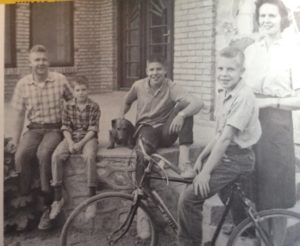Afghanistan, First Peace Corps Staff
Robert Steiner, the only Vermonter at the time to direct a Peace Corps program overseas, insists that “Afghans are like Vermonters—both are proud, independent and frugal.” He notes that they are generally wary of foreigners, including, sometimes, Peace Corps Volunteers. “Afghanistan has only recently known foreigners other than invading armies,” he points out. “Experience has taught them to be wary—to see a foreigner in their country for other than military purposes is to many of them a novelty.”
Information about the Peace Corps was first brought to Afghanistan by Cleo Shook, a Peace Corps program officer with extensive experience in that nation. On a two-month visit which began in December, 1961, Shook was told that Afghanistan wanted Volunteers. Afghan caution, however, resulted in a limited program—the nine Volunteers who arrived in Afghanistan on September 6, 1962, to inaugurate the program were all assigned to work in the capital city of Kabul—five of them as secondary teachers, three as nurses and one as a heavy equipment and automotive mechanic. This small group was met at the airport by Steiner, who, as Acting Peace Corps Representative, had already been in Kabul for one month.
Stein was born and raised in Iran where his father was a professor at Alborz College in Teheran. He was thus fluent in Farsi, which is not only the language of Persia but also the most widely spoken language in Afghanistan. A 1942 graduate of Wooster College in Wooster, Ohio, he served as a fighter pilot in World War II before continuing his studies aat Columbia University where he obtained a master’s degree in international affairs.
In 1950, he joined the Foreign Service for a two-year assignment back to Teheran—as cultural affairs officer in the U.S. Embassy. He then spent one year with the U.S. Office of Education in Washington arranging training programs for foreign educators and technicians brought to this country under foreign aid grants.
He remained in Washington from 1954 to 1959 as program director for the American Friends of the Middle East. His duties included responsibility for the operation of six offices in the Middle East. He arranged lecture exchanges and cultural programs in the U.S. working in cooperation with Middle East student organizations.
In 1959, he left Washington and moved to Vershire, Vt., as executive vice president and half owner of the Vershire Company and Judgment Ridge Company, firms involved in poultry raising (18,000 laying hens), recreation (a rope-tow for skiing) and real estate (2000 acres of mountain resort country). Steiner came to the Peace Corps in August, 1962, and left promptly for Afghan tan, while his Volunteers were still in training at Georgetown University, training with the first group to Ethiopia. Trainees that numbered over three hundred.
Afghan caution about Volunteers evaporated on acquaintance. The Peace Corps’ nine young men and women went at their jobs in Kabul with enthusiasm and no nonsense. Officials of this nation, after taking a hard look at the Volunteers, asked for more. On March 15, 1963, a second group, composed of teachers and printing experts—the latter to assist in a textbook program, went into training at Georgetown University. The 26 Volunteers of Afghanistan II arrived in Kabul on June 13, just in time to help Steiner celebrate his promotion to Peace Corps Representative.

No comments yet.
Add your comment